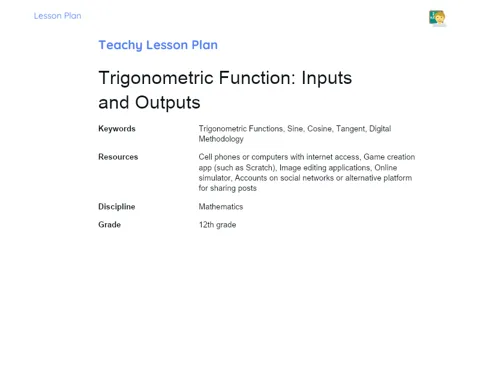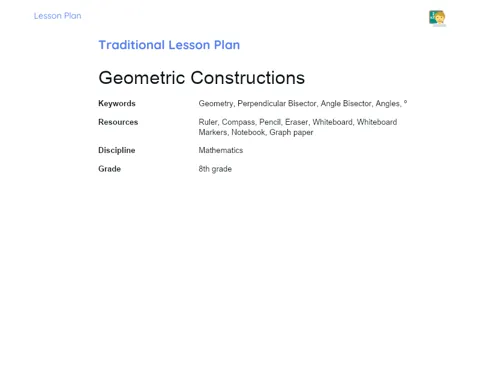Objectives (5 - 7 minutes)
-
Understand the concept of the area of a square: The teacher should start the lesson by reminding the students about the concept of area, which is the measure of the surface of a figure. Then, introduce the concept of a square, a geometric figure with four equal sides and four right angles.
-
Apply the formula for the area of a square: Next, the teacher should present to the students the formula to calculate the area of a square, which is the side squared. The students should understand that by squaring the side, they are multiplying the side by itself.
-
Solve practical problems involving the area of a square: After understanding the formula, the teacher should then present to the students a series of practical problems involving the calculation of the area of a square. The students should be encouraged to solve these problems, applying the formula they have learned.
Secondary Objectives:
-
Encourage logical reasoning: Through problem-solving, students should be encouraged to think logically and apply what they have learned.
-
Promote understanding of geometry: When working with the area of a square, students should be able to visualize and better understand geometric concepts.
-
Develop calculation skills: Solving problems involving the area of a square will also help develop the calculation skills of the students.
Introduction (10 - 15 minutes)
-
Review of Previous Concepts: The teacher should start the lesson by reviewing basic geometry concepts, such as what a square is, and how to calculate the perimeter and diagonal of a square. This review is essential for students to understand the new concept that will be addressed - the area of a square.
-
Problem Situation 1: The teacher can present the following situation: 'Imagine we have a square with one side measuring 5 cm. If we want to cover the surface of this square with tiles measuring 1 cm x 1 cm, how many tiles will be needed?' This situation will prompt students to think about how to calculate the area of a square and how this can be applied in practice.
-
Problem Situation 2: The teacher can then present the following situation: 'Now, imagine we have a square-shaped piece of land and we want to build a fence around it. If each fence post needs to be placed every 2 meters, how many posts will be needed?' This situation will also require students to calculate the area of the square to find the answer.
-
Contextualization: The teacher should explain that calculating the area of a square is an important and useful skill in various everyday situations, such as construction, architecture, gardening, among others. Therefore, it is essential for students to understand and be able to apply this concept.
-
Introduction to the Topic: To spark students' interest in the topic, the teacher can share some curiosities about the square and its area. For example, the teacher can explain that the square is the only figure that has equal sides, angles, and diagonals, and that the area of a square is always the side squared. Additionally, the teacher can mention that the square is one of the most used figures in geometry and mathematics in general, and that understanding how to calculate its area is a valuable skill.
Development (20 - 25 minutes)
-
Theory - Area Concept (5 - 7 minutes): The teacher should start the theoretical part by explaining what the area of a figure is. They should emphasize that the area is a measure of the surface of a figure and is always expressed in square units. The teacher can use examples of flat figures that students are familiar with, such as boards, floors, etc., to illustrate the concept of area.
- Activity 1 - Area of Flat Figures (3 - 5 minutes): Next, the teacher can propose an activity in which students must calculate the area of different flat figures, such as squares, rectangles, triangles, etc. The goal of this activity is to reinforce the concept of area and prepare students for the Introduction of the formula for the area of a square.
-
Theory - Formula for the Area of a Square (5 - 7 minutes): The teacher should then introduce and explain the formula to calculate the area of a square, which is the side squared. They should explain that by squaring the side, they are multiplying the side by itself.
- Activity 2 - Deduction of the Formula (3 - 5 minutes): To help students better understand the formula for the area of a square, the teacher can propose an activity in which they must deduce the formula themselves. The teacher can start by drawing a square on the board and dividing it into small squares with a side length of 1. Then, they can ask the students how many small squares are needed to cover the original square. The students should realize that as many small squares are needed as the side of the original square. Thus, they will have deduced the formula for the area of a square.
-
Theory - Application of the Formula (5 - 7 minutes): The teacher should explain that to calculate the area of a square, one simply needs to measure one of the sides of the square and square that measurement. They should show several examples of calculating the area of squares using the presented formula.
-
Activity 3 - Calculation of Square Areas (3 - 5 minutes): After presenting the examples, the teacher can propose an activity in which students must calculate the area of various squares using the presented formula. The teacher should walk around the room, assisting students who have difficulties and correcting errors.
-
Activity 4 - Problem Solving (3 - 5 minutes): Finally, the teacher can propose solving some problems involving the calculation of the area of a square. The problems should be challenging enough to stimulate students' reasoning, but not so difficult as to discourage them. The teacher should encourage students to think independently but should also be available to assist them if needed.
-
Return (8 - 10 minutes)
-
Group Discussion (3 - 4 minutes): The teacher should promote a group discussion about the solutions found by students for the proposed problems. Each group should share with the class the strategy they used to solve the problem, and the teacher should guide the discussion by asking questions that encourage students to explain the reasoning behind their solutions.
-
Connection with Theory (3 - 4 minutes): The teacher should then make the connection between the solutions found by students and the theory presented. They should highlight how the formula for the area of a square was applied to solve the problems, and how the concepts of area and square are interrelated. The teacher can also mention other applications of calculating the area of a square in everyday life to reinforce the importance and usefulness of this concept.
-
Individual Reflection (2 - 3 minutes): Finally, the teacher should propose that students reflect individually on what they learned in the lesson. They can ask questions like: 'What was the most important concept you learned today?' and 'What questions have not been answered yet?' Students should write down the answers in their notebooks, and these can serve as a starting point for the next lesson.
-
Teacher Feedback (1 minute): The teacher should then give overall feedback on the lesson, highlighting the positive points and areas that need improvement. They should encourage students to continue studying the subject at home and to seek the teacher if they have any doubts. The teacher should also reinforce the importance of calculating the area of a square and how it can be useful in various everyday situations.
Conclusion (5 - 7 minutes)
-
Summary of Contents (2 - 3 minutes): The teacher should briefly review the main points covered in the lesson, reinforcing the concept of the area of a square and the formula to calculate it. They should also emphasize the importance of understanding and correctly applying these concepts, as they are fundamental not only in mathematics but also in various areas of everyday life, such as architecture, engineering, gardening, etc.
-
Theory-Practice Connection (1 - 2 minutes): The teacher should explain how the lesson connected theory, practice, and applications. They should review the activities carried out, highlighting how they helped students better understand the theory and apply the concept of the area of a square in practical situations. The teacher can also mention again the problem situations presented at the beginning of the lesson, emphasizing how students were able to apply what they learned to solve them.
-
Extra Materials (1 - 2 minutes): The teacher should suggest some extra materials for students who wish to deepen their knowledge of the area of a square. These materials may include math books, educational websites, YouTube videos, among others. The teacher should encourage students to explore these materials at their own pace and to seek the teacher if they have any doubts.
-
Everyday Applications (1 minute): Finally, the teacher should emphasize once again the importance of calculating the area of a square in everyday life. They can give examples of how this concept is applied in everyday situations, such as painting a wall, planning a garden, calculating the amount of tiles needed to cover a floor, etc. The teacher should emphasize that mathematics is not just an abstract and theoretical discipline, but a practical and useful tool that can help us solve many everyday problems.



